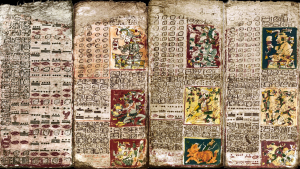Amate and the Preservation of Indigenous Identity
Amate is a type of thick handmade material that is made by pressing the inner bark of ficus trees together into flat sheets. Because of its manufacturing process, amate is technically not a paper, which is made from the pulp of plant fibers that have been macerated into a pulp. However, it is an important material that is significant to early bookbinding. Archeological studies have dated the manufacture of bark paper to over 1500 years ago, with the practice originating within the pre-colonial Latin America. The Maya codices that have been preserved such as the Dresden Codex are written on amate. The use of bark paper by the Mayan civilization shows strong cultural and environmental ties. The use of ficus bark to create paper was a logical choice due to its ease of availability, its smooth surface, and its durability. Most of what was written on these early amate prints was information that was central to the culture and beliefs of the Mayans. Amate was primarily used for two purposes, as production and tribute from smaller villages, and as ritual for Mayan religious practices. Because these writings contain information with sacred and/or historical significance, the preservation of these codices, and any amate writings, is directly related to the preservation of Mayan culture.
In the years following the colonization of Latin America, the Spanish prohibited the use of bark paper by the indigenous people in part due to its use in religious ceremony. For these indigenous groups, the amate would be cut into the shape of figures and decorated for use as tribute in ceremony. Of the amate codices that have been preserved, only 16 contain writings and artwork that is from the pre-colonial period. The remaining 500 codices contain colonial bibles and other missionary writings. There has, however, been a resurgence in the creation and use of amate in the modern era. During the 1960s, two indigenous groups, the Nahua and the Otomi, began to greatly increase the production of amate and sell the paper as a handicraft for commercial purposes. This increase in production coincides with the increased recognition of indigenous Latin American groups. Both of these indigenous groups had a long tradition in the use of bark paper, with the Otomi using the amate for religious ritual purposes, and the Nahua using the amate as an artistic production. There are multiple perspectives on which group pushed began this modern resurgence, but the outcome of a new awareness for national and indigenous identity remains the same.
The production of amate can be seen here as two forms of preservation through action. In the first form, the physical papers themselves have been preserved partially due to the durability of the materials. The bark paper is thicker and somewhat more durable than later wood pulp papers, which has allowed the codices to remain in strong enough condition for later conservators to analyze and extract important information. The second form is the preservation of religion and culture. Through the reemerging practice of creating and designing amate paper works, Latin American indigenous groups have been preserving their religious practices and their traditional artwork.
Resources
Berger, Sidney. Rare Books and Special Collections. American Library Association, 2014: 80-81.
López, Citalli. The Endurance of Mexican Amate Paper: Exploring Additional Dimensions to the Sustainable Development Concept. Dissertation, University of Twente, 2003. http://doc.utwente.nl/38707/1/t0000004.pdf.
Image from: http://www.latinamericanstudies.org/dresden-codex.htm
______________________________________________________________________
Contributed by Elizabeth Mayer

